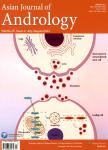Re-epithelialization resulted from prostate basal cells in canine prostatic urethra may represent the ideal healing method after two-micron laser resection of the prostate
源自前列腺基底细胞的前列腺部尿道再上皮化方式可能是2微米激光犬前列腺切除术后创面理想修复方式作者机构:Department of Urology Shanghai First People's Hospital Shanghai Jiaotong University Shanghai 200080 China Department of Urology Guizhou Provincial People's Hospital Guiyang 550002 China Department of Pathology Guizhou Provincial People's Hospital Guiyang 550002 China
出 版 物:《Asian Journal of Andrology》 (亚洲男性学杂志(英文版))
年 卷 期:2015年第17卷第5期
页 面:831-838,I0010-I0011页
核心收录:
学科分类:10[医学]
基 金:the Foundation in Guizhou supported financially by a grant from the National Natural Science Foundation of China
主 题:basal cell benign prostate hyperplasia re-epithelialization two-micron laser wound healing
摘 要:The purpose of this study is to characterize the re-epithelialization of wound healing in canine prostatic urethra and to evaluate the effect of this re-epithelialization way after two-micron laser resection of the prostate (TmLRP). TmLRP and partial bladder neck mucosa were performed in 15 healthy adult male crossbred canines. Wound specimens were harvested at 3 days, and 1, 2, 3, and 4 weeks after operation, respectively. The histopathologic characteristics were observed by hematoxylin and eosin staining. The expression of cytokeratin 14 (CK14), CK5, CK18, synaptophysin (Syn), chromogranin A (CgA), uroplakin, transforming growth factor-β1 (TGF-β1), and TGF-β type Ⅱ receptor in prostatic urethra wound were examined by immunohistochemistry and real-time polymerase chain reaction, respectively. Van Gieson staining was performed to determine the expression of collagen fibers in prostatic urethra and bladder neck would. The results showed that the re-epithelialization of the prostatic urethra resulted from the mobilization of proliferating epithelial cells from residual prostate tissue under the wound. The proliferating cells expressed CK14, CK5, but not CK18, Syn, and CgA and re-epithelialize expressed uroplakin since 3 weeks. There were enhanced TGF-β1 and TGF-β type Ⅱ receptor expression in proliferating cells and regenerated cells, which correlated with specific phases of re-epithelialization. Compared with the re-epithelialization of the bladder neck, re-epithelialization of canine prostatic urethra was faster, and the expression of collagen fibers was relatively low. In conclusion, re-epithelialization in canine prostatic urethra resulted from prostate basal cells after TmLRP and this re-epithelialization way may represent the ideal healing method from anatomic repair to functional recovery after injury.



